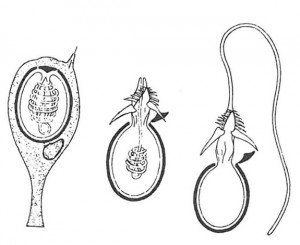
The red jellyfish, Cyanea capillata is almost brown-yellow. Its disk can be as big as a plate and can carry up to five meters long stinging tentacles behind it. On the stinging tentacles are cnidoblasts, which at touch uncoil and release corrosives. They are used to paralyze their prey: small crustaceans, fry, etc., but can also be unpleasant for bathing people. The affected area of the skin feels painful and turns red.
The blue jellyfish, Cyanea lamarckii has a beautiful cornflower blue color. It is about the size of a small saucer. The species is common in the southern part of the North Sea, but are rarely seen in coastal waters. The blue jellyfish’s stinging tentacles are shorter than those of the red jellyfish, but burn just as much.
Precautions
Avoid getting too close to the stinging jellyfish when bathing in the sea. Usually pain and redness disappears after a few hours. In particularly severe cases, you can remove a portion of the corrosives by lathering and shaving the affected area of skin. To ease the pain you can apply ointment or liniment for soothing the effects of pain from sunburn.




